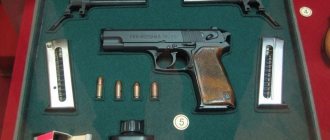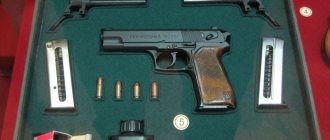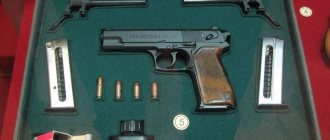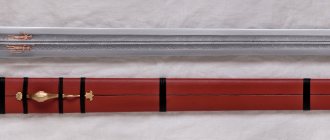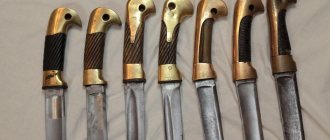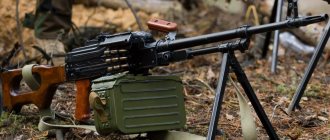The history of the development of the Russian army is in many ways a collective image, which is based on the military traditions of medieval Europe and the Ottoman Empire. The military system, uniforms and combat tactics were borrowed from European armies. The technical equipment was equally represented by weapons and equipment of all types and types, which were used both in Europe and in the East. In every historical era, one or another type of weapon appears in the arsenal of the Russian army. Since the reign of Moscow Prince Vasily II the Dark, the ranks of the military militia in the Moscow army have been replenished with special military formations, warriors - squeakers. These detachments were armed with long arquebuses, and the riflemen used a reed ax as an auxiliary combat weapon.
Berdysh and the Streltsy
The weapon was very reminiscent of the halberds common in Europe, which had a slightly different purpose. The security units of the Turkish army were armed with similar weapons. Despite the fact that battle axes, pikes, and halberds were used in almost all armies of the world, the berdysh can easily be classified as Russian “know-how.” A Russian archer in a long red caftan, armed with a arquebus and a massive ax on a long shaft, became a symbol of the military power of the Russian state in the Middle Ages. They did not squeak and muskets became symbols of the Streltsy army, namely berdysh. These weapons remained in service with the Russian army until the reign of Peter I, who subsequently abolished the Streltsy regiments.
Universal weapon
When it comes to native Russian authentic edged weapons, sooner or later the berdysh comes up.
On the same topic
Educational program: who are Streltsy
A battle ax with a wide curved blade on a rather long handle. A characteristic feature is the so-called “braid,” a kind of metal “tail” that was tied to the shaft with a belt or rope. In Russia it was in circulation in the 15th–17th centuries; The ancestry most likely stems from Turkish battle axes (which, however, did not have braids).
A simple universal weapon that can cut, shallowly stab, chop well, and, on occasion, can also be used to cut; put it in the hands of Jackie Chan, and he will instantly build you such a working technique - you will gape. But, of course, it is better to use a reed against a weakly armored enemy.
There are plenty of myths around it - about secret ancient Russian fencing techniques, and about magical chopping and cutting properties, and about outlandish methods of application: “The Sagittarius were masters of hand-to-hand combat no worse than Chinese Kungfu players; The berdysh easily chopped steel armor into cabbages; the Cossacks also tied it to their backs and crawled under the enemy cavalry, cutting the bellies of horses!”
In general, the weapon of a real ninja, at the same time, is also a support for the squeaker. There were many types of berdyshes, only the royal decree of 1656 standardized the appearance of the blade and the length of the shaft at 142 centimeters (in the original - two arshins) with the obligatory “inflow” - a metal spike in the lower part.
Various types of Russian berdyshes from the book “Historical description of clothing and weapons of Russian troops,” ed. Viskovatova A.V., Part 1. - St. Petersburg. : Military type., 1841-1862.—Ill. 68
This weapon has one feature: many small holes located along the blunt part of the blade. Their purpose still remains unclear; At the same time, the authors of serious studies (Dvurechensky, Chubinsky, etc.) avoid this topic. But “every gopher in the field is an agronomist,” so “holes in a row” give Internet experts on everything in the world a reason to organize another holivar.
Why am I worse? I'm also a level 80 couch expert!
Therefore, let's briefly look at the versions circulating on the Internet that try to explain why this element was needed in the design of classic Russian edged weapons - and criticize them. But I warn you right away: all my further fabrications are nothing more than the fruit of the logic of a middle-aged humanist of the 20th–21st centuries.
Combat use
Since ancient times, axes and axes have been in service with armies. Berdysh is a cold contact pole weapon. Skillful use made it possible to inflict tangible and fatal wounds on the enemy. They can be applied:
- chopping;
- chopping and cutting;
- piercing injuries.
For combat use, weapons were carried by the archers, the city guards, and the townspeople. It had a belt and could be worn behind the back, and in battle the reed stuck into the ground served as a support for the gun.
Holes were made on the back of the blade, which, according to existing versions, were needed to put the cover on the metal sheet.
This weapon was used in the defense of Pskov from the soldiers of Stefan Batory. People who witnessed those events said about it that it was capable of inflicting terrifying wounds that were fatal. But it is not very suitable for close combat due to the long shaft, so skill is required to use it.
The archers, on foot, first carried out fire strikes to kill, which contributed to confusion and panic in the attacking regiments. After the shot was fired, the infantryman wielded the reed.
The tactical conduct of the battle by the militia was simpler; they made abatis from the reeds, a simple fortification field fortification that stopped the attack of the enemy’s cavalry. When the militia introduced hand-to-hand combat, he, armed with a reed, fought off the horsemen or attacked the enemy infantry.
With the help of arquebuses, muskets, and reeds, the enemy received a worthy confrontation and it is not surprising that after this the enemy removed from the battle, leaving the corpses of his soldiers on it.
A small technical clarification
At least a thousand reeds of different types and varying degrees of preservation have survived to this day - in museums, of course; It is simply impossible to find out how many of them are in private collections of antique lovers. Some blades have holes along the spine, some do not; Some blades with holes have metal rings inserted into them.
I’ll immediately draw your attention to the technology for making holes: at the time of the widespread use of drills, the situation with drilling machines in Rus' was bad: they had not yet been delivered. Therefore, the holes were made using special punches, having previously heated the blade and made it plastic. This explains both the irregular shape of the holes and the heterogeneity of their sizes: in some places the blacksmith’s blow was stronger, in others weaker.
(Photo source)
Naturally, the edges of the metal were not subjected to any grinding or polishing - this is not Excalibur, but a simple “peasant’s spear,” as defined by the compiler of the Russian-English dictionary of 1618–1619. Richard James. This is what we will proceed from.
Story
Berdysh is a favorite research object for historians, so there are many theories about its origin. According to one of these theories, the berdysh is a modernized ax with a wide blade, used in the Baltic countries and Scandinavia. The term itself, according to linguists, can have several roots. There are Hungarian, Polish and German traces here. But it was the Poles in Russia who used the word “bardysz” or “berdysz”, which, in turn, came from “barducium”.
In Europe, weapons similar to the reed appeared quite early. The first mentions of it were recorded in miniature chronicles of the 13th century. The berdysh cannot be considered an exclusively European weapon. Similar axes were used in Egypt in the 15th century. Their distinctive feature was a month-shaped canvas. The lower end of the canvas fit tightly to the shaft and rested against it. From these axes came the Turkish Teber axes.
There is no consensus about when axes appeared in Rus'. The first mention of the berdysh as a wax weapon dates back to the time of Ivan IV (the Terrible). The Livonian War required immediate reform of the army. After the famous reforms of Ivan the Terrible, the Russian army was replenished with rifle regiments, which were armed with berdyshes.
The cavalry was armed with short axes or balts. Peasants were required to keep berdysh in case of war. Russian wars were accustomed to using axes. The blades of their weapons could differ in shape and size. Early canvases had one point at the top, and the blade was axe-shaped, from 20 to 50 cm in length. By the 17th century, the shape of the canvas had changed. A second, distinct point appeared, and the length of the blade increased to 80 cm. There were also ceremonial reeds. Their canvases were decorated with carved patterns. The total length of the weapon reached 170 cm.
Over time, professional infantry appeared in the army. The impetus for the development of this type of troops was the prevalence of firearms. A new type of troops was immediately introduced in Rus', despite the fact that the theory of fighting on foot was practically absent. Berdysh helped our ancestors defend themselves from the attacks of the Janissaries, Polish hussars and Tatar cavalry. Only the reforms of Peter I removed the berdysh from the equipment of the Russian army.
Tying a stretcher
According to the author of this version, the berdysh was not just a weapon, but a real old Russian multi-tool, which the archers used for everyday needs: either as a support for a tent, or as a hanger for a boiler over a fire.
Criticism: the enemy attacked the camp, a battle ensued - but the fighters had no weapons: a cauldron with porridge hung on the berdysh and a shelter for the night, yeah.
I will quote (from the Runet):
“But let’s return to the logical versions in the field of transport applications. Two reeds tied together can serve as the basis for more load-bearing structures. Thanks to the design of the blade, it is very easy to make a stretcher from two such “modules”; you just need to insert a few crossbars into ready-made grooves.
Does this design seem too complex for 17th century people? Now imagine that you need to drag two wounded people 50 kilometers: how will you do this if there is no cart and horse?”
From my humble point of view, the rainbow world of the author of this theory is distinguished from reality by one key point: the existence of a certain Magic Rope, whose presence immediately disables physical laws. This is such a special thing that every Sagittarius has; it very quickly crawls into any holes on its own and never rubs against sharp edges (let me remind you once again - they were not drilled, but punched into the metal). An ordinary, commonly used rawhide leather strap will not do here; no, it will be too wide for such holes.
In the case of a forced march of 50 kilometers with the wounded, I personally will try to cut down a couple of poles in the nearest forest and make a drag, this will allow the patients to be placed with much greater comfort than on the protruding points of the poles. And the weapon will be intact.
“What will happen if this structure is simply placed on the ice of the river? We know that in winter there is almost no snow along the river beds, right? That's right, you'll get an excellent sled. And in the summer, such a structure can be used as a drag on the grass if there is a special need.”
In general, of course, this device looks more like the base of a rocking chair than a sled. For sleds, perhaps, it is necessary to spread the support points on the ice wider, that is, tie the reeds not by the blades, but by the handles. But sleds made with the help of the Magic Rope never fall apart, the reeds do not need additional fastening spacers and do not fall on their sides, and the blades do not bend or become dull. I'm not even talking about the mythical absence of snow on river ice - this is normal in the World of Rope.
There is also a constant fair wind blowing there: you can make a sail out of a caftan and install it on a sled - you will get a boat, you can cut through a frozen river at great speed. And here’s what it looks like to carry the prey by archers using multi-tool reeds:
And again the Magic Rope, which doesn’t care about a sharpened blade...
I will reveal to the supporters of this version a terrible secret: tying the legs of a transported animal to the harnesses in such a complex way is worthy only of fans of the ancient obscene Japanese art of “shibari”. Normal people simply tie the front and hind legs/paws of the prey in pairs and slide a pole under the ties. Fast and practical.
Disadvantages of the reed
The reed, like any other weapon, has its drawbacks. If an enemy was encountered, dressed in strong armor, then a blow with a reed would practically not harm him. The exception was a direct blow, but you still need to manage to deliver it. As for glancing blows, the armor protected the warrior quite tolerably. The second significant drawback is the inability to resist heavy cavalry. Berdysh could be used against a cavalryman only when the cavalry was stopped by the barriers placed or lost its inertia and “choked” in the thick of the infantry.
Finally, the third drawback was the tactics of using weapons. Units armed with reeds and arquebuses could not effectively fight in units that were built according to the European model, namely: musketeers and halberdiers covered the pikemen in close combat. The pike was longer than the axe. It was because of the listed shortcomings that the berdysh did not become the flagship of the Russian army, but by the middle of the 17th century it turned into an infantry weapon, and the infantry should not have been with musketeers. The infantryman's combat tactics were based on actions in loose formation.
As noted earlier, the effectiveness of the reed is disputed by many historians and eyewitnesses. If you wish, you can familiarize yourself with excerpts from the chronicles, where the advantages and disadvantages of the ax are indicated. But by the end of the 17th century, the passion for axes in the army had subsided, as a new century was dawning - the century of mass reformations and reformations in the army in particular.
Bondage in a stockade
This idea, expressed in the book “Ancient Rus' and the Great Turan” by a certain Oleg Mikhailovich Gusev, looks like this: “Tied with hair cords and staggered in several rows, and even disguised with grass and branches, hundreds of berdyshes presented an impenetrable obstacle to the advancing cavalry. Their blades ripped open the bellies of galloping horses, and riders flying out of their saddles flew into the next rows of deadly axes. The attack floundered, and the best cavalry fell into a bloody meat grinder...”
Fence made of reeds
In addition to the assumption of the existence of the same Magic Rope, this “version” raises many questions. For example:
Why couldn’t ordinary sharpened and burnt stakes be used to construct the fence?
The construction of a barrier of hundreds of reeds implies taking them away from the fighters. The main weapon was allowed onto the fence. How did the archers fight after the enemy cavalry turned this fence into dust and the squeaks were discharged?
Were only imbeciles recruited into the enemy cavalry - or were ancephalics also allowed to ride a horse? Overnight, strange bushes suddenly appeared on the battlefield! Ambush? Trap? Of course not - it was the Russian governor who decided to plant a flower garden!
Let's not bypass it, but trample it with horses - because of this, the Russian governor will be very upset and may even die.
And if the enemy attacks in a detour on foot, and does not trample headlong with cavalry, will the enemy infantry also pierce their bellies?
If you really need to install the reeds with the blade straight up, why not just put them in a suitable spacer? And if you build the fence according to the drawing, why can’t you pass a couple of ordinary (non-magic) ropes between the blunt end and the braid, which would be much faster?
And finally, how long did it take to pass several layers of Magic Ropes through dozens of reeds?
When trying to answer these questions, a fairly stable impression is created about the mental abilities of the Streltsy army. And a lot becomes clear about the author of the book “Ancient Rus' and the Great Turan”.
Attack Stopper
But still, first of all, the berdysh remained a cold weapon. Their fighting techniques were extremely varied. Of course, the basis was chopping blows. But the long “half-moon” blade with a smooth curve also made it possible to stab effectively. And the cutting blows were directed, first of all, against the cavalry - the horses' legs were cut off. By the way, Russian mounted archers and dragoons also used reeds, but shortened so that they could fight in the saddle. The fighting techniques were generally similar to those used by European halberdiers or warriors who fought with gleyi (a long blade placed upright on a shaft). The shaft of the berdysh was called a warrior's camp. Its end was almost always sharpened, and often bound with iron or even a spear tip was placed there. This was called “podtok” or “kopeytso”. However, the inflow was intended, first of all, to stick the reed into the ground. But, as a last resort, they could unexpectedly strike the enemy.
It was necessary to strengthen the reeds in the ground to create an effective barrier, designed, first of all, to stop a horse attack. For this purpose, there were many holes in the blades of the reeds. A string was pulled through these holes, the reeds themselves were turned over with the curve of the blade upward and stuck into the ground at an angle, towards the advancing enemy. A short wooden stake was placed under the butt. Such an improvised stockade was erected very quickly by skilled warriors, and it was extremely difficult to overcome it, especially when there was dense, well-aimed shooting from arquebuses towards them.
Cord - identification mark
On the same topic
10 “school” misconceptions about knightly armor
The only version that allows the use of a rope - but not a magic one, but a colored one. Yes, such a lace (or a combination of them), passed through the holes, could be an identification mark of the weapon belonging to a specific owner or military unit. Are there any such samples preserved? Well, rags generally don’t last, time doesn’t spare anyone.
It seems to be true, with one small exception: the berdysh is a weapon “for the street,” and outside there is rain, snow, fog and other precipitation. Any rope absorbs moisture. And moisture on iron is a direct path to corrosion. Low-quality iron, which, as we remember, served as the main material for making reeds, rusts badly. That is, over time, grooves eaten away by corrosion will appear between the holes in the blade (and the thickness of the reed blade, frankly speaking, is small). The weapon is weakened and may break, which means it should be thrown away.
The price for beauty is too high, don’t you think? True, such a tie with colored cord could only be used on major holidays - “on the name day”, but was it worth it to complicate the manufacture of weapons for the sake of such rarity? The blacksmith will not do anything for free.
Reed shafts, underflows, braids
to the begining
Not all berdysh in the collections and exhibitions of museums have original shafts; there are 18th, 19th and even 20th centuries. Later shafts are usually painted, often with a round cross-section. The fastening of the blade is generally very rough; it can often be observed that the shaft is too large for the eye and is trimmed to the required size. The inflow (“kopeytso”) and fastening for the running belt are, as a rule, absent.
Genuine shafts are distinguished primarily by their cross-section, which is a flattened octagon (less often an oval), as well as by the presence of a characteristic stop under the blade, at the eye itself. There are also underflows on them, and of different shapes, from a simple tip made of a sheet of iron stuffed onto a shaft, to a faceted dart. It is extremely rare, due to poor preservation, but it is still possible to fix the fastening elements of the shoulder strap - a ring at the eye and a special cutout in the lower third of the shaft.
The blade is attached to the shaft, either original or restored, using small forged nails (from three to eight) driven through holes in the butt and braid. There are two options for making the braid; it is either forged in the form of a strip, the plane of which is perpendicular to the plane of the blade (in this case, it is adjacent to the shaft, nailed with one or two forged nails, which secure the eye, and additionally tied to the shaft with a narrow leather strap). or is a continuation of the plane of the blade (in this case it fits into a special groove on the shaft and is secured with a pin through the hole).
The length of a genuine reed shaft is well known: “two arshins,” i.e., about 1.5 m (however, this size is valid only for 1656), and the cross-section is easily determined either by measuring existing samples, or based on the width of the eye, approximately 4x2 cm or 4x2.5 cm. The parameters of the shafts of earlier times remain unknown to this day.
Shoulder straps, or at least fragments of them, have not survived to this day, and documents and visual sources do not contain any information about the material from which they were made. It is unknown whether it was leather (waxed, rawhide) or wicker or woven braid (silk, linen, cotton). They could well have used both braid and leather, but there is no evidence of this yet.
| A copy of the reed, made in the workshop of V. Terekhov (Tula) | Type 2b reed, general view (left) and blade (right). Kharkov Historical Museum. | Types of inflows: 1 – from a sheet of iron stuffed onto a shaft; 2 – in the shape of a faceted dart. |
| A method of attaching a blade to a shaft using a special “tongue” that creates a strong attachment of the blade to the shaft (left). The tip of the “feather”, formed in the form of edges (right). Options for braids. | ||
For beauty
This version, from my point of view, explains absolutely everything. Those who have a tighter wallet can order a full-fledged cut-out design, and inlays with precious metals, and so on. True, it won’t be very strong.
And those who have less money are satisfied by other methods. The simplest way to decorate even the simplest weapon without resorting to special tricks is to beautifully decorate it with holes. I’m not even trying to refute this version, because showing off is a great thing, more valuable than money.
Holes for balance rings
conclusions
Berdysh as a type of pole weapon appeared in Russia in the middle of the 16th century. and was apparently borrowed from the Ottoman Empire. Its direct analogue and probable ancestor is the Turkish “tirpan”. Based on pictorial, written and material sources, it is possible to determine the main types of berdysh that were in service with the Russian infantry from the late 40s to the mid-80s of the 17th century. These are types 1a , 1c , 2b , 2d , 2d .
Statements about the heaviness of reeds are true for types 1d , 1z-2 , 2a .
Berdysh was present in the arsenal of Russian archers and soldiers in the middle and second half of the 17th century as a very effective pole weapon in hand-to-hand combat, especially against enemy infantry, and could be used as a support for a musket when shooting, but, most likely, relatively rarely, since how the weight of the musket already made it possible to fire from the hands without additional support.
Author: A. E. Pisarev. Almanac of Army and Battle. 2008/9.
Holes for balance rings
Massive rings attached to the blade made it possible to increase the weight and change the balance of the reed, which made it possible to tailor a standard weapon to the individual characteristics of a particular fighter. An analogy: it’s difficult to chop wood with a light hatchet, but it’s just right with a heavy cleaver; inertia increases.
Oddly enough, from my point of view, this version has a right to life. If, of course, we assume the existence of a certain school of fencing with berdysh...
A trace in history and computer games
The outcome of many battles depended on the quality of the weapons used by Russian warriors:
- Sabel.
- Broadswords.
- Spears, peaks, spears.
- Berdyshey.
And with this simple arsenal, the Russian army was able to deliver crushing blows to the enemy.
In our time, reeds have also found their use.
Computer game developers equipped their heroes with them. They skillfully reflect blows with these weapons in such games as “Fire and Sword”, “Assassin”, “Cossacks”, “Mini Ninja”, “Kung Fu Rabbit”.
Rings inserted into holes are a badge of honor
Participation in campaigns is one link, killing someone at work is another. Making notches on the shaft (like on a butt) is not so beautiful, and the shaft will begin to actively absorb water, delaminate, and deteriorate. And here everything is immediately visible. Imagine the scene: at night, in the uncertain light of the torches near the city wall, a gang of thieves is dividing up the swag taken from an unlucky merchant. Suddenly a night watch appears: three archers armed with reeds. The leader of the gang loudly yells: “At them, guys, equally us, we’ll fight our way!” Baring their teeth predatorily, the murderers take out crooked boot knives and begin to approach.
The senior watchman, however, does not show any traces of fear: casually playing with his berdysh and quietly blowing the criminal romance “I am a dashing boy, the outskirts know me” into his beard, he gently approaches the robbers. The rings on the blade rattle, not boding well. The leader of the gang looks at the berdysh, thinks in his mind, quickly turning pale: “What does he have, four rings on his blunts, and six on his braid - four trips to Izyumsky Shlyakh and six hacked to death with his own hands?!” The knives fall into the mud. “Bro, sorry, there was something unclear, let’s get out of here!” - that’s it, they were wasted, like a gloomy night.
It's beautiful, isn't it? Moreover, the rings could be made of precious metals. Silver - for a dozen killed, gold - for special distinction in front of the royal person. And the fact that such samples have not been preserved is a matter of everyday life - I wanted to drink, had no money, went to the blacksmith, took out the link, and took it to the tavern.
The musketeers, there, were famous drunkards - why are the archers worse?
That’s why they stopped handing out such insignia. You drank once, you drank twice, you won’t get enough of them. And not everyone will brag about such a background. Russian people are believers, God-fearing, and it is not becoming for them to boast about murder, it seems that only completely lost little heads are capable of such a thing.
But the holes remained, the blacksmiths, according to the Tsar’s decree of 1656, forged all the berdysh according to a single model, they were given them with holes - they copy it. Inertia is common.
Against foot and horse
You can imagine what a berdysh is in skillful hands by reading the memoirs of those who had to experience it for themselves. This is how the Polish nobleman Jan Pasek, who participated in the Russian-Polish war of 1654-1667, described the battle with the archers: “The massacre in this crowd was cruel here, and the most terrible were the berdysh; after a quarter of an hour, however, they did not come out of this confusion, but they flogged them so that not one escaped, since they remained in an open field, they said there were about 100 of them. Of ours, the one who lay down lay down, and the one who stayed - he suffered from wounds; The bay horse under me was wounded in the chest by a bullet, his forehead and also his knee were cut with a butt. He would still have served me if not for this knee wound, since I was lucky to the best of my ability in the army.”
Sound signal
According to this version, the holes were intended for rings, and these rings rattled loudly when the reed shaft hit the ground. Such a streltsy night watch is going on, tapping and rattling, and howling: “Sleep well, residents of Baghdad, the capital! The potato plant is sleeping—go to sleep, too!”
The version is, of course, beautiful, but it won’t take long to ruin the shaft. Besides, the rings do not jingle that loudly; it would be better to attach bells to the holes. Even better - a cow boot. But it’s really good to use instead a device that has been used in Rus' since ancient times and is called KOLOTUSHKA. Lightweight, convenient and noisy instrument, I recommend it.
Klim Zhukov writes on this occasion: “Ringing rings served as a very simple way of communication. You hit the ground with the flow, the rings jingled, which means you’re in the ranks.” And if someone doesn’t want to join the ranks, he doesn’t put on rings. What if it’s a battle, and everyone is shouting and clanking sabers? Go figure out who to give the signal to and who will hear it...
On the other hand, if we talk about ceremonial weapons (honor guard), then the version has the right to life. An important guest entered the room - the archers stood at attention, their eyes bulging, the shaft “knock!” on the floor, the rings “blink!” — they show respect, like clicking their heels. I believe.
Weight and dimensions of reeds
to the begining
In accordance with the national historical and weapons tradition, a certain general stereotype about the “massiveness” of the reed has become established. Is it so? To establish objective truth, it is necessary to determine the parameters of the surviving samples. The weight and dimensions of the blades range from 600-800 g to 1.5 kg and from 30 cm to 30 cm in length. At present, it is most permissible to give a real description of the reeds of grades 1a and 2b , as very widespread and accessible. Thanks to Yu.V. Kvitkovsky and the workers of the Kharkov Historical Museum established the sizes of blades typical for their subgroups.
| Reed blade type 1a. The butt is cut from a sheet at the same time as the blade. Kharkov Historical Museum | Genuine reed shaft. Elements for fastening the running belt are visible. Golden Gate Museum, Vladimir |
1. Blade type 1a (Kharkov Historical Museum).
A distinctive feature is the design of the butt, which is not made as a separate part and then welded to the blade with an overlap, but is cut from a sheet along with the blade, bent and forged.
Weight 1300 g. Total length including braid 80cm, without braid - 72cm. The spring of the blade in the area of the butt, excluding the latter, is 7.5 cm. The size of the upper part of the blade from the butt is 30.5 cm, the size of the lower part of the blade from the middle of the butt is 37.5 cm. The thickness of the blade along the blunt is no more than 2.5 mm.
2. Berdysh type 2b (Kharkov Historical Museum).
A distinctive feature is the original shaft. Its overall configuration is unique and has no analogues. It is thicker than usual, the lower end is broken, there are two protrusions, the purpose of which is unclear. It is difficult to date it. Judging by the size, taking into account the fact that the lower end is broken, it cannot be attributed to 1656.
Weight including shaft 3.1 kg (most of the weight is on the shaft). The total length including the shaft is 169 cm. The length of the shaft is 145 cm. The cross-section is a flattened octagon, 4×2.8 cm. The total length of the blade including the braid is 69 cm. The width of the blade in the butt area without taking it into account is 15.5 cm. The thickness of the blade at the blunt 3 mm. The height of the upper part of the blade is 25.5 cm. The height of the lower part of the blade from the butt, excluding the braid, is 30.5 cm.
3. Blade type 2b (Cheboksary region, private collection, accidental find. Similar samples are stored in the State Historical Museum).
A distinctive feature is the design of the butt, which is not welded to the blade with an overlap, but is cut together with it from one sheet, forged and welded (for similar reeds from the State Historical Museum, the butt is welded with an overlap).
Weight – 800 g. Total length including the braid is 70 cm. The length of the blade without the braid is 60 cm. The width of the blade in the butt area is 15.5 cm. The size of the upper part of the blade from the butt is 25.5 cm, the size of the lower part of the blade from the middle of the butt is 34.5 cm. The blunt thickness of the blade is 3-4 mm. The height of the upper part of the blade is 25.5 cm. The height of the lower part of the blade or butt excluding the slant is 30 cm.
Improving the combat properties of weapons
There is a whole group of assumptions here, let’s break them down briefly.
The rings are like swivels. Carrying a reed on your back in a stowed position? A rich idea, why waste your time. But why then SO MANY holes and rings? Two would be enough. And any piece of rope or leather strap with a tightening loop will do the job just as well.
Holes are for weight reduction. It seems logical, but how much will the weight be reduced from so many small holes? One or two percent? I don't believe in such a measure of relief. If you want to reduce weight, make the yelman a centimeter lower or the sample underneath it wider, it will make more sense.
The holes prevent the blade from getting stuck in the wound. They retain air, which prevents the wound from sucking the blade inside. In principle, such an effect really exists; modern manufacturers of kitchen utensils produce such knives - with a stamped edge and a number of holes.
But to achieve the effect, it is necessary that the holes are located near the cutting edge, and not at all at the butt, as on the reed. Will not work.
On the same topic
Stab or chop: what did the cavalrymen choose?
Resonator rings. According to this version, the blade of the reed could get stuck in the enemy during a chopping blow, after which it would be very difficult to rip it back out. And when struck, the rings rattled and hit the metal of the blade - it vibrated, loosening the alien flesh, and the blade did not get stuck. Very convenient: put it in, take it out, and run. I simply won’t comment on this due to lack of personal experience. But I will assume that a shaft of this length is a very serious lever with which you can rip a weapon out of any wound without special vibration rings.
Rings to limit the depth of impact. Similar arguments on the same topic. But, from my point of view, with a piercing blow, the strongly expanding front part of the tip (by analogy with sabers, let’s call it elmanya) serves as a much more effective limiter, and with a chopping/cutting blow, the larger width of the blade will prevent deep penetration. Rings won't help here.
To parry an enemy's blow. Well, yes, on some Chinese swords such an element is present: when blocking a blow with the upper, blunt side of the blade, the rings can to some extent hold up someone else’s sword and slow down its movement.
But a reed is not a sword. It has a shaft above the blunt end; on occasion, it will meet someone else’s blow - for this purpose, a special strip of iron was attached to it. No, that’s clearly not what the rings are for...
Holes - stress relief in metal. If we were talking about alloy steels and further complex heat treatment of the entire piece of iron - well-o-o-o-o... But since we are talking about not very high-quality iron, which was used for “consumer” weapons, I doubt it. I also doubt that the entire fabric of the product was hardened: if they increased the hardness, they also increased the fragility.
I will assume that, most likely, only the area near the cutting edge was heated (“zone hardening” is by no means a new invention), and the back part remained “raw” and therefore more plastic: it was deformed, but did not break.
On the same topic
10 “school” misconceptions about Russian military history
Turkish guest
First of all, it is worth saying that the berdysh was not exclusively a shooting weapon. The persistent myth according to which long-shafted axes were specially issued to archers for use as a bipod (stand) when shooting from heavy arquebuses has long been refuted by numerous facts. Firstly, the Berdysh came to Rus' in the 15th century, when the Russians did not yet have military branches with firearms. Similar long axes were used in Europe (Switzerland, Scotland, Poland, etc.) and in the Ottoman Empire.
According to historians, it was from the Turks that they migrated to our region. The Turkish name "tirpan" became "berdysh" (this word was most likely borrowed from High German, where barda meant "broad axe"). Berdysh was first mentioned in Russian chronicles in 1468. True, archaeologists have not yet found a single such early example. The specimens stored in museums mainly date back to the 16th century or even to a later period - the Time of Troubles. Secondly, there is a lot of evidence that ordinary infantrymen and even militias armed themselves with berdysh. Peasants were supposed to keep a certain supply of weapons in case of war. In the surviving lists of these arsenals there are also berdyshes.
But, alas, there are no detailed descriptions of how to use the reed. So scientists have to reconstruct this on their own. Experiments have shown that the reed is actually quite convenient if you use it as a stand for a arquebus. This greatly improves the quality of shooting (the squeaks were heavy, and it was almost impossible to aim well while holding them suspended). However, it is wrong to say that this was his main purpose.
In the documents of the Streltsy army there are records of the purchase of cushions - special light supports for firearms. They were much more effective in this role than the Berdysh. Light pads hung on the wrist and were ready for use instantly. The berdysh first had to be taken out from behind the back (it was worn on a special belt attached to the shaft). In addition, a sharp blade (and they were sharpened very carefully, because it is known that not only chopping, but also slashing blows were applied with burdocks) created an unnecessary danger for the shooter. Most likely, at first the reed was used as a support for the arquebus by the most experienced and skilled archers, who did not want to carry around an extra piece of equipment (pods). And only then, quite likely, this practice became widespread.
Bottom line
It seems that's it. Even the WARHEAD.SU sofa expert was unable to determine the exact purpose of the “holes.” But, in any case, we rejected the most delusional versions - and thus moved the matter forward. In my opinion, the proliferation of blades with holes is a blind copying of some old, now forgotten “military fashion.”
At the same time, a reed - especially one made of modern steel - is a very serious weapon, an indispensable thing in a zombie apocalypse. I recently acquired just this and rounded the edges of all the holes - just in case. Suddenly you have to tie a rope...
Stamps and drawings on the blades of the reeds
to the begining
Most reed blades, as mentioned above, are not marked with brands or any other marks, but there are exceptions.
The copy from the Kirillo-Belozersky Monastery features a scene of a unicorn fighting a snake. The exhibits of the Tula Museum of Weapons are decorated with a dotted pattern with a bird (eagle or dove). The dotted pattern is also applied to samples stored in the Trinity-Sergius Lavra Museum-Reserve and in the National Museum of the Republic of Tatarstan. In the collection of the Novodevichy Convent there is a reed with a wave-like ornament along the butt of the blade. But the most mysterious are the images on two reeds from the collection of the Novodevichy Convent. On one, type 1a , there is a half-length portrait of a man in armor and with a shield, and the inscription: “Grand Duke Ivan”; on the other, type 2b , there is a horseman with an ensign in his hands, on which a calvary cross is visible, and along the blade, next to with a drawing, an inscription of religious content and a letter dating. The meanings of these images, as well as the exact dating of the weapons, remain unclear.
Pistol OTs-27 "Berdysh"
OTs-27 “Berdysh” is a Russian-developed pistol, created at TsKIB SOO (Central Design and Research Bureau of Sports and Hunting Weapons) in Tula. The pistol was developed in the early 1990s. The pistol was originally developed for the needs of the Russian army and law enforcement agencies. Famous gunsmiths I. Ya. Stechkin and B. V. Avraamov worked on the pistol. The first presentation of the OTs-27 “Berdysh” took place in 1994. A special feature of this pistol model was that it was equipped with a quick-release barrel, which made it possible to adapt the Berdysh to use several calibers at once: 7.62x25, 9x18 and 9x19 mm. This sample of small arms was born as a result of development work to create a combat army pistol on the theme “Rook”. The creators’ intention was to use 4 types of cartridges at once: 9x18 PM, 9x18 PMM, 7.62x25 TT and the 9x19 mm Parabellum cartridge, common in the West, required an interesting solution from the creators of the pistol - the implementation of a modular design. Conversion of a pistol to use the desired cartridge is carried out by the owner of the weapon himself; the process of replacing the barrel takes no more than 40 seconds.
As part of the work to create a new pistol, the TKB-0220 pistol, developed jointly by Stechkin and Avraamov, was presented at TsKIB SOO. However, this pistol was removed from the ongoing competition on the theme “Rook”. For this reason, in 1993, the new development was presented as a commercial or “police” model. The pistol was modified and received a new designation OTs-27 “Berdysh” (OTs in the name stands for “TsKIB sample”). In addition, this pistol was also known under the designation PSA - Stechkin-Abramov pistol. In 1996, this model was presented as an option for arming personnel of the Russian Ministry of Internal Affairs.
The automatic operation of the OTs-27 "Berdysh" pistol operates by using the recoil energy of a free massive bolt. A spring recoil buffer was placed in the lower bolt lug, and the recoil spring is located around the barrel of the pistol. The role of the barrel shutter stop is its closure, which is mounted in the frame. In general, compared to the older model of the Stechkin automatic pistol (APS), the OTs-27 had a simpler design, as well as slightly better ergonomics. Moreover, in the version chambered for the 9x19 mm Parabellum cartridge, it also surpassed the APS in power.
The design of this pistol successfully combined simplicity with very practical and original solutions. The barrel automation worked on the principle of recoil with a free shutter. In the extreme forward position, the bolt-casing was held by a return spring located on the barrel, as well as by its own weight, locking the barrel bore. The barrel itself was made quick-release; the shooter could replace it directly in the field. The idea of using 7.62 mm caliber cartridges from the TT pistol in this pistol was due to the good ballistic data and high penetration ability of the latter. In addition, this bullet had a flat flight path, and Soviet military warehouses were bursting with this ammunition. At the time of the creation of the OTs-27 "Berdysh", the PM cartridge was the standard pistol cartridge for Russian law enforcement agencies and the army. It remains so at the present time, gradually losing its position to the 9x19 mm cartridge.
In the early 1990s, the Parabellum cartridge was already considered as a promising replacement for the old PM cartridge, so the creators chose it as one of the options. A similar Russian cartridge was designated 9x19 PSO. The initial bullet speed for this cartridge was 350 m/s. At a distance of 25 meters, it could provide the next level of accuracy - a group of hits in a circle with a diameter of 100 mm. Thanks to the use of a wide chamber bevel with an optimal angle of inclination on the pistol, the OTs-27 pistol reliably fired cartridges that were equipped with expansive bullets of various designs. The pistol should have included three interchangeable barrels.
In the inner front part of the pistol casing there is a device for damping the recoil of a shot, to put it simply, a shock absorber made in the form of a polymer insert, as well as a buffer (steel rod), which is held by a fastening screw from the front edge of the bolt casing. At the end point of the rollback, the buffer collides with the detent, reducing the shutter-shroud speed. This occurs due to the absorption of part of the energy generated at the moment of the shot by the shock absorber. This solution extinguishes part of the recoil energy, extending the life of the weapon. Moreover, this fairly simple design solution makes shooting from the OTs-27 pistol more comfortable for the shooter, and also allows for increased accuracy of fire.
The bolt-casing latch installed on the pistol, which lowers down when disassembling the pistol, is located immediately in front of the trigger above the trigger guard. The ejector also acts as an indicator of the presence of a cartridge in the chamber, protruding beyond the surface of the bolt-casing, which helps the shooter accurately determine whether the weapon is loaded, both by touch and visually. The cartridge case is ejected to the right and up after the shot.
The pistol is equipped with a hammer-type firing mechanism, with a double-action safety cocking mechanism. The trigger pull when shooting with the hammer cocked is approximately 2.5 kg, and when shooting self-cocking - 6.5 kg. At the same time, the trigger stroke is quite short, smooth, with quite acceptable force. There are 2 shooting options possible: with pre-cocking and self-cocking. The OTs-27 is also equipped with a safety lever with a double-sided flag, which, when turned on, blocks the trigger, bolt and firing pin (flag in the middle position). In this case, the trigger can be locked both in the cocked and in the lowered position. A safe (without firing) decocking of the hammer can be accomplished by moving the safety catch upward. After releasing the trigger, the flag automatically returns to the middle position (gun on safety). With the safety lever down, the pistol is ready to fire.
The frame of the pistol, like its bolt-casing, is made entirely of weapons-grade alloy steel. Despite this, and also not the smallest dimensions, the OTs-27 “Berdysh” is not very heavy and has great survivability. Its handle easily accommodates a two-row magazine with a slight angle of inclination, which was done to ensure high reliability of the weapon. At the same time, this solution provides control and very comfortable holding of the pistol when shooting. At the base of the trigger guard there is a double-sided magazine latch.
There was also a version of the pistol, equipped with a special protrusion on the back surface of the handle, to which the butt could be attached. The OTs-27 pistol has a very high service life. One of the prototype pistols fired about 50 thousand shots. Moreover, during all this time, only the return spring, firing pin and magazine were replaced in the pistol. To store and carry a pistol along with three barrels, the OTs-27 could be equipped with a special briefcase. When the pistol is not completely disassembled, it is divided into a minimum number of parts. The gun is quick and easy to maintain, easy to clean, disassemble and reassemble.
The pistol's sight is constant and consists of simple non-adjustable rear sight and front sight. The rear sight has a fairly wide rectangular slot, and the front sight has a rectangular cross-section. For ease of aiming at dusk and at night, special markers with a glow-in-the-dark composition are applied to the front and rear sights of the sight. The shape of the OTs-27 trigger guard is designed for firing with two hands (a two-handed grip of the weapon is implemented). Directly under the gun barrel there are guides designed for attaching various attachments. For example, a laser designator can be placed here. Depending on the selected bullet caliber, the pistol can be equipped with double-row box magazines of various capacities for 18 (9x18 PM) or 15 rounds (7.62x25 mm).
For a number of reasons, this pistol did not go into wide production. At the same time, the pistol is produced at the production facilities of KBP and is available in two versions: OTs-27 caliber 9x18 PM and OTs-27-2 caliber 9x19 "Parabellum". A small number of these pistols entered service with various units of the Russian Ministry of Internal Affairs (private security), as well as special forces of the Federal Penitentiary Service. Since 2006, the Berdysh pistol has been in service with the Russian prosecutor's office as a self-defense weapon for investigators and prosecutors. In addition, since 2005, this pistol has also been an award weapon (the pistol includes 2 magazines and 36 rounds of ammunition).
Technical characteristics: Caliber - 9 mm, 7.62 mm. Weight - 930 g, without cartridges. Length - 200 mm, height - 143 mm, width - 35 mm. Barrel length - 125 mm. Cartridges used: 9x18 mm PM, 9x18 mm PMM, 9x19 Par and 7.62x25 mm TT. Sighting range - 50 m. Magazine capacity - 18 (15) rounds.
Sources of information: https://www.armoury-online.ru/articles/pistols/russia/psa https://www.arms-expo.ru/photo/ognestrelnoe-oruzhie/9kh19-pistolet-ots-27-2- berdysh https://gunsru.ru/rg_pistol_OTs27_Berdysh_ru.html https://www.megasword.ru/index.php?pg=132 https://vitalykuzmin.net/?q=node/568
